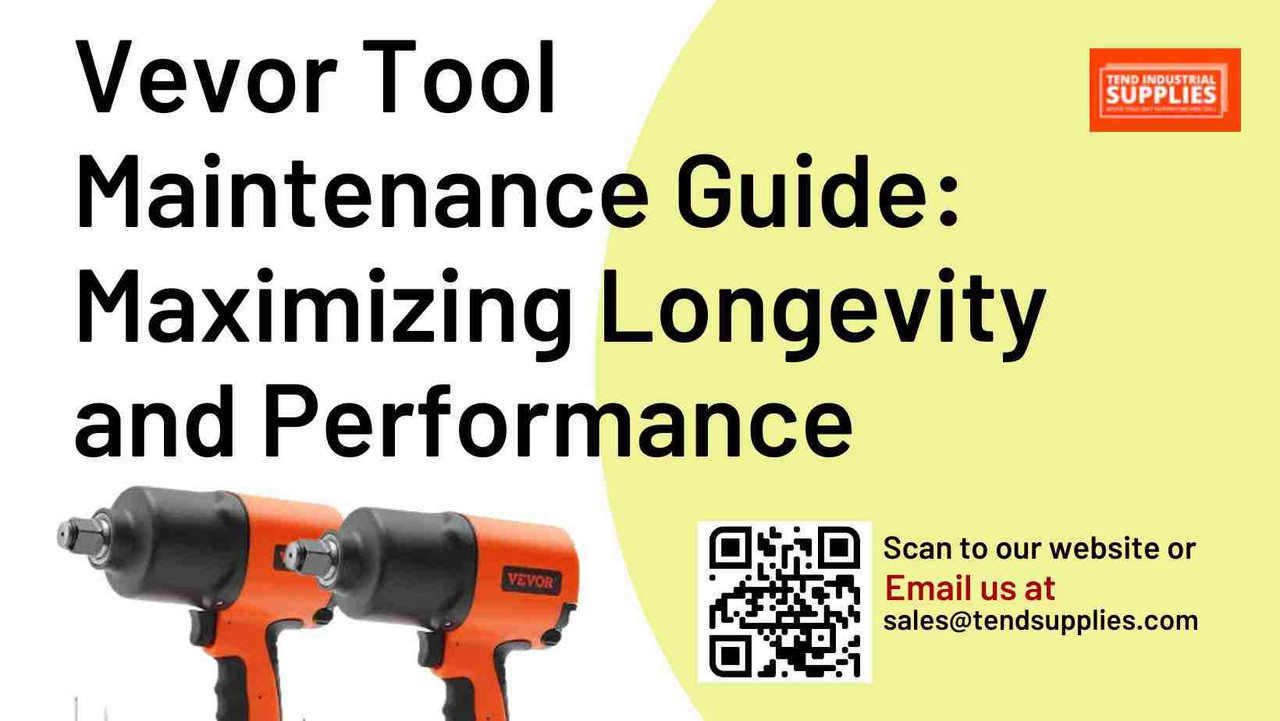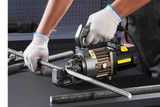Vevor Tool Maintenance Guide: Maximizing Longevity and Performance
Key Takeaway
Regular maintenance is essential for preserving the functionality and extending the lifespan of your Vevor tools. This involves routine cleaning, proper storage, timely lubrication, and addressing wear and tear promptly. By incorporating these maintenance practices into your workflow, you can significantly enhance tool performance, ensure safety, and protect your investment. Remember, a well-maintained tool is a reliable tool, and with Vevor's quality construction, proper care can keep your tools operating at peak efficiency for years to come.
Now, let's dive into the specifics of maintaining your Vevor tools for optimal performance and longevity.
Introduction
Power Tools maintenance is a critical aspect of operations across various industries, from construction and manufacturing to automotive and woodworking. Proper maintenance not only ensures that tools perform at their best but also extends their lifespan, reducing the frequency of costly replacements and downtime. In industries where efficiency and reliability are paramount, well-maintained tools like Vevor can make the difference between a job well done and costly delays. Regular upkeep helps prevent wear and tear, enhances safety, and maintains the precision and power needed for complex tasks.
An effective maintenance guide should include routine cleaning, proper storage, and timely repairs to address wear and tear before they escalate into bigger issues. Begin by cleaning your tools after each use, removing dirt, dust, and debris that can cause damage over time. Lubrication is another critical step; applying the correct type of lubricant prevents rust and keeps moving parts operating smoothly. Storage also plays a significant role in maintenance—tools should be stored in a dry, organized space to prevent damage and ensure easy access. Regularly inspect your tools for any signs of wear, such as dull blades, frayed cords, or loose parts, and address these issues promptly. Following these steps ensures your tools remain in optimal condition, ready to deliver peak performance whenever needed.
In this comprehensive guide, we'll explore best practices for tool care, from basic cleaning to advanced maintenance techniques. By following these tips, you'll not only extend the life of your tools but also ensure they perform at their best when you need them most.
General Maintenance Tips for All Vevor Tools
Regardless of the specific type of tool, these general maintenance practices apply to all Vevor equipment:
1. Clean After Every Use
- Remove dust, debris, and any residual materials
- Use compressed air to clean hard-to-reach areas
- Wipe down surfaces with a clean, dry cloth
2. Proper Storage
- Store tools in a dry, clean environment
- Use original cases or dedicated toolboxes
- Avoid extreme temperatures and humidity
3. Regular Inspection
- Check for loose parts or damage before each use
- Inspect power cords and plugs for wear or fraying
- Ensure safety guards and mechanisms are functioning correctly
4. Read the Manual
- Familiarize yourself with manufacturer-specific maintenance recommendations
- Follow guidelines for recommended service intervals
5. Use Tools Properly
- Don't overload or misuse tools beyond their intended purpose
- Respect the tool's limitations to prevent unnecessary wear
Specific Maintenance Guidelines for Different Vevor Tool Categories
Power Tools (Drills, Saws, Sanders)
- Battery Care (for cordless tools)
- Fully charge batteries before first use
- Avoid complete discharge; recharge when power begins to decrease
- Store batteries at room temperature
- Clean battery contacts regularly
- Motor Maintenance
- Keep vents clear of dust and debris
- Periodically clean with compressed air
- Check and replace brushes when worn (if applicable)
- Blade and Bit Care
- Keep cutting edges sharp
- Clean and oil bits and blades after use
- Replace when worn or damaged
Air Compressors
- Tank Drainage
- Drain moisture from the tank after each use
- Use the drain valve located at the bottom of the tank
- Air Filter Maintenance
- Clean or replace air filters regularly
- Check manufacturer guidelines for frequency
- Belt Tension (for belt-driven models)
- Check belt tension periodically
- Adjust or replace belts when loose or worn
- Oil Level and Quality (for oil-lubricated models)
- Check oil level before each use
- Change oil according to manufacturer's schedule
- Use recommended oil type
Welding Equipment
- Cable Inspection
- Check welding cables for cuts or exposed wiring
- Ensure connections are tight and clean
- Consumable Maintenance
- Inspect and replace consumables (tips, nozzles) regularly
- Clean spatter from contact tips and nozzles
- Gas System Care
- Check for gas leaks regularly
- Ensure proper gas flow and pressure
- Cooling System (for water-cooled models)
- Check coolant levels and quality
- Flush and replace coolant as recommended
Woodworking Tools (Table Saws, Planers, Routers)
- Blade and Bit Sharpening
- Keep blades and bits sharp for clean cuts
- Have professional sharpening done or replace when necessary
- Table and Fence Alignment
- Regularly check and adjust table flatness and fence alignment
- Use precision tools for accurate adjustments
- Bearing Lubrication
- Lubricate bearings according to manufacturer's recommendations
- Listen for unusual noises that might indicate bearing wear
- Dust Collection
- Empty dust collection bags or bins regularly
- Clean dust ports and hoses to ensure proper suction
Measuring and Layout Tools
- Calibration
- Regularly check calibration of measuring tools
- Recalibrate or replace if accuracy is compromised
- Clean and Dry Storage
- Store in a dry environment to prevent rust
- Use protective cases for delicate instruments
- Battery Replacement (for digital tools)
- Replace batteries promptly to avoid corrosion
- Remove batteries for long-term storage
Advanced Maintenance Techniques
For those comfortable with more in-depth maintenance:
1. Motor Brush Replacement
- Check motor brushes for wear (usually accessible via screw caps)
- Replace when worn down to about 1/4 inch in length
- Always use manufacturer-approved replacement parts
2. Gear Lubrication
- Open gear housing carefully
- Clean old grease and replace with fresh lubricant
- Use the type and amount of grease specified in the manual
3. Switch and Trigger Mechanism Cleaning
- Use electrical contact cleaner on switches and triggers
- Ensure the tool is unplugged before cleaning
- Allow to dry completely before use
4. Cord Replacement
- Replace damaged power cords immediately
- Ensure proper gauge and type of replacement cord
- Follow manufacturer guidelines for cord attachment
Maintenance Schedule
To keep your Vevor tools in top condition, follow this general maintenance schedule:
After Each Use
- Clean the tool
- Inspect for damage
- Store properly
Weekly
- Thorough cleaning of all tools
- Lubricate moving parts
- Check calibration of measuring tools
Monthly
- Detailed inspection of power cords and plugs
- Clean motor vents
- Check and tighten all screws and fittings
Annually
- Deep clean all tools
- Professional inspection of heavily used tools
- Replace worn parts
- Recalibrate precision tools
Troubleshooting Common Issues
Even with proper maintenance, issues can arise. Here are some common problems and solutions:
- Tool Not Starting
- Check power source and connections
- Inspect fuses or circuit breakers
- Examine brushes for wear
- Loss of Power
- Clean air vents
- Check for cord damage
- Inspect batteries for cordless tools
- Unusual Noises
- Tighten loose parts
- Check for damaged gears or bearings
- Ensure proper lubrication
- Inaccurate Cuts or Measurements
- Realign guides and fences
- Sharpen or replace blades
- Recalibrate measuring tools
Frequently Asked Questions
1. How often should I clean my Vevor power tools?
Clean your Vevor power tools after every use to prevent buildup of dust and debris. A more thorough cleaning should be done weekly, paying special attention to vents and moving parts.
2. Can I use any type of oil to lubricate my Vevor tools?
It's best to use the lubricant recommended in your tool's manual. Different tools may require different types of lubricants. Using the wrong type can potentially damage the tool or reduce its efficiency.
3. How do I know when it's time to replace the brushes in my Vevor electric motor?
Most Vevor tools with brushed motors will show signs of decreased performance when brushes need replacement. Typically, brushes should be replaced when they're worn down to about 1/4 inch in length. Some tools have brush wear indicators.
4. Is it necessary to drain my Vevor air compressor after every use?
Yes, it's crucial to drain the moisture from your air compressor tank after each use. This prevents rust and ensures the longevity and proper functioning of your compressor.
5. Can I sharpen Vevor saw blades myself, or should I have them professionally sharpened?
While it's possible to sharpen some blades yourself with the right tools and skills, professional sharpening is recommended for most saw blades to ensure precision and maintain the blade's integrity.
Related Article
Unleash Your DIY Potential: Vevor Tools for Home Improvement and Beyond
Hand Tool Maintenance: Tips for Longevity and Performance
Conclusion
Proper maintenance is key to ensuring the longevity and optimal performance of your Vevor tools. By incorporating these maintenance practices into your routine, you can significantly extend the life of your tools, improve their performance, and ensure they're always ready when you need them.
Remember, a little preventive maintenance goes a long way. Not only does it protect your investment, but it also enhances safety and efficiency in your work. With Vevor's commitment to quality and your dedication to proper care, your tools can provide reliable service for years to come.
Ready to get the most out of your Vevor tools? Visit Tend Industrial Supplies for a wide range of Vevor tools and maintenance accessories. From lubricants to replacement parts, we have everything you need to keep your tools in top condition.
Contact us at sales@tendsupplies.com for personalized maintenance recommendations and support.
Invest in the longevity of your tools today. Proper maintenance not only protects your investment but also ensures you're always ready for your next project. Shop Vevor tools and maintenance supplies at Tend Industrial Supplies now!









